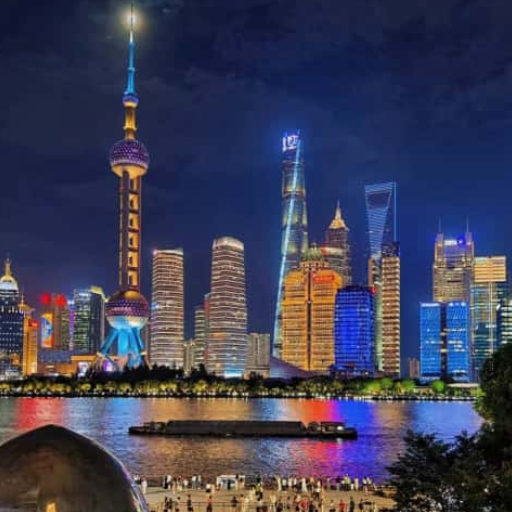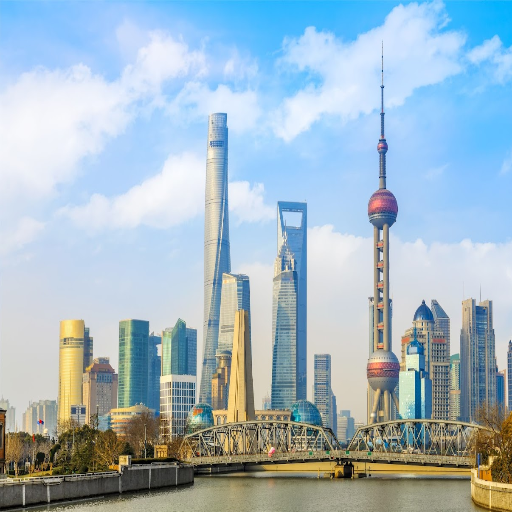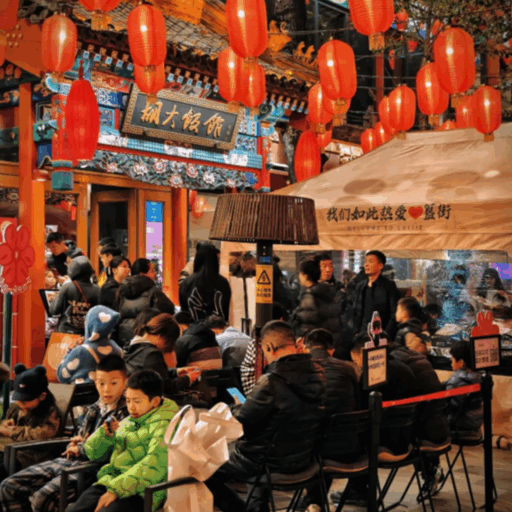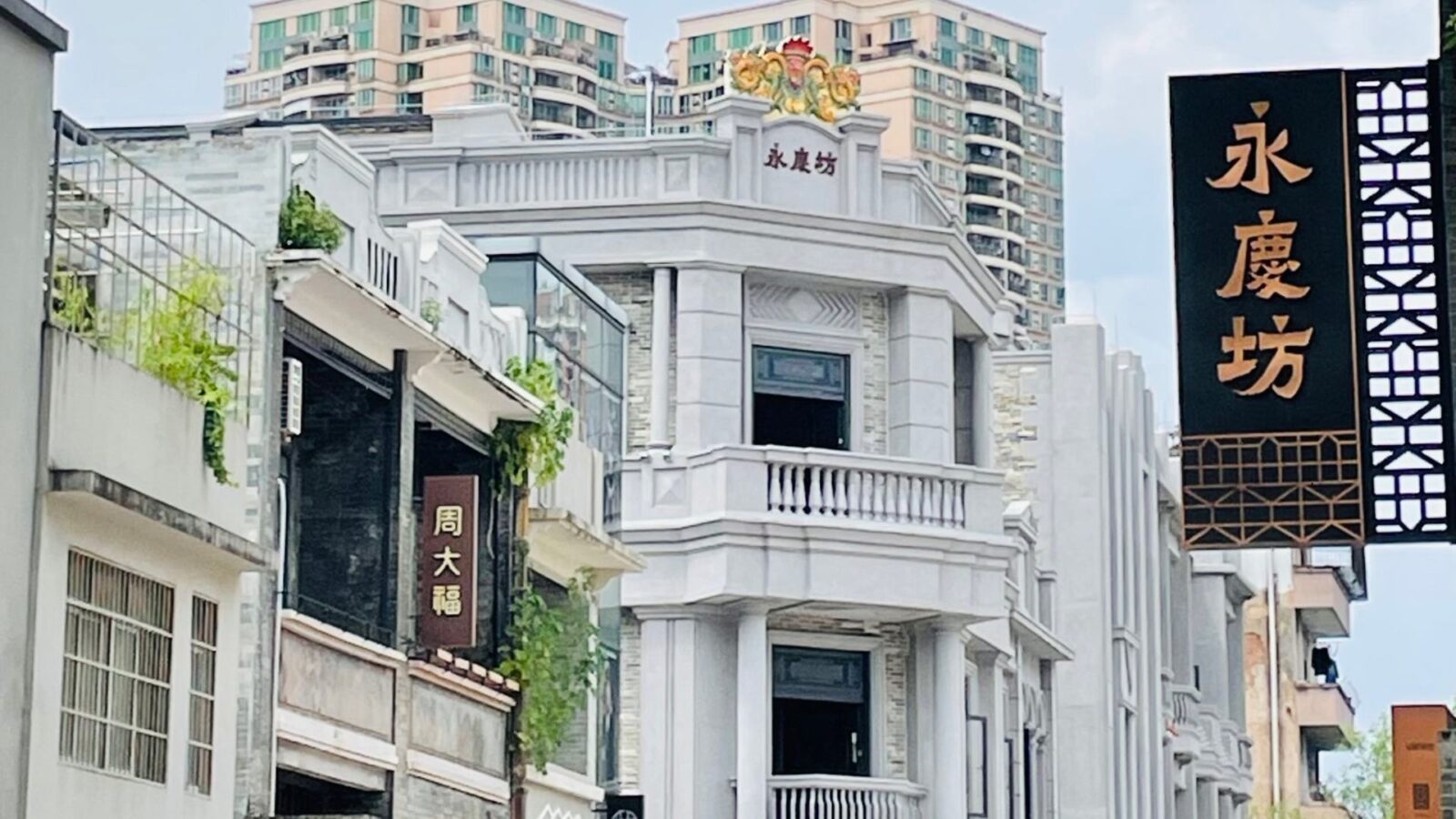Shanghai is a city rich in history, while simultaneously incorporating modernization, exciting travelers with new possibilities. Beneath its famed skyline and crowded streets lies a trove of undiscovered treasures that showcase the city’s blend of culture, history, and innovation. This guide helps you uncover the unexplored marvels of Shanghai, from cozy alleyways and tranquil gardens to unconventional museums and artisanal markets. If this is your first time visiting or you're someone with prior experience but looking for a different perspective, this article will help you change your perception of Shanghai. Get set to uncover treasures bound to leave you spellbound and have memories of a lifetime!
What are the Top Things to Do in Shanghai?

Exploring the Bund and Its Most Celebrated Views
The Bund is a historic waterfront section of Shanghai, China, situated on the bank of the Huangpu River. Bund epitomizes the merger of ancient and modern Shanghai. Walking the 1.5 km long promenade, one can see the skyline of the city and the Shanghai Tower, Pearl Tower, and other large skyscrapers in the Pudong district. Furthermore, the Bund has colonial undertones and a collection of bombastic infrastructure spanning England, Spain, China, and France.
Furthermore, these structures are magnificent to observe with their lights on. The buildings cast a yellowish-orange light while passengers ride on a boat around the river, adding to the aesthetic. Bound serves as a center for many luxurious places to dine or shop, while offering customers eye-catching views. For those fond of architecture, the Bund is a complex set of buildings representing various eras, so for anyone visiting Shanghai, the Bund is a must-visit place.
Must-Visit Attractions In Pudong
Pudong is home to some of Shanghai's most important modern landmarks and cultural centers. The district is sustained by literally hundreds of towers, the most famous of which is the Oriental Pearl Tower, from which visitors can view the entire city of Shanghai through its numerous observation decks. This tower is located at the heart of Pudong, blending seamlessly with the tourism-driven essence of this region. For a blend of entertainment and science, families with children and science enthusiasts can have their inquisitive minds piqued at the amusement-like exhibits and displays at the Shanghai Science and Technology Museum.
Apart from that, nature lovers can enjoy a relaxing time at Century Park, the largest park in Shanghai, which offers great lawns, peaceful lakes, and recreational activities like boating and cycling. This region also features Shanghai Tower, the second-tallest building in the world, which offers unparalleled views of the city alongside numerous shops and dining options at its base. Not to forget, vibrant Lujiazui opens its windows to luxurious shopping malls, the atmosphere of fine dining restaurants, and incredible skyline views that further enhance the charm of Pudong. All of these sites add up to Pudong’s fame as one of the top regions for both leisure and modern tourism.
Experiencing Shanghai at The People’s Square
The People’s Square is widely known and recognized as one of the most vibrant and lively places in Shanghai, serving as a cultural and historical center. With all the juxtaposed buildings and architectural wonders, this one spot gives access to some recently developed places of interest for both local citizens and tourists, showcasing the intechnl feats and artistic beauty that the city holds.
The People's Square is one of the largest public squares in the center of Shanghai, containing some of the city's most famous landmarks, such as the Grand Theatre, which is renowned worldwide for its architecture and world-class performances. Immediately next to the Square is the Grand Shanghai Museum, which features a rich and diverse collection of fossils. Also located next to the Shanghai Museum is the Shanghai Urban Planning Exhibition Center, which appeals to people of all ages with its unique models and helps visitors learn about Shanghai's past, present, and future possibilities.
People's Park is the perfect place for those looking to escape the needless exhaust and enjoy fresh green sights. This park is the best spot to visit on weekends, as it hosts one of the most unique locations in the world, known as “the marriage market.” Here, parents from all over the city bring their children to meet prospective partners, socialize, and eventually get married. Shanghai is perfect for culture enthusiasts who frequently visit to enjoy the art performances at People’s Square, a metro station located in the heart of Shanghai. This entire Square represents the heart and undying love for culture.
What Unique Cultural Tours Can You Take in Shanghai?

Exploring Real Local Culture in the French Concession
The French Concession of Shanghai contains historical information of the colonial period as it has preserved architecture interlaced with modern construction, which is in line with the rest of the world. Tours can explore the city’s history by taking walks through Roadside Art Deco and Shikumen structures, which are significant to the city’s architectural history. These architectural wonders house modern boutiques, cafés, and art galleries that are inspirational to culture, all showcasing the elegance of history mingled with modern artistry.
An authentic local experience is guaranteed by visiting the Tianzifang market, a maze of narrow streets filled with local design shops, restaurants, and bars that welcome everyone. In addition, Fuxing Park offers a glimpse into local life, where the area's population practices Tai Chi, chess, dances, and more, embodying the gentle pace of Oriental culture in a European-style setting. The French Section creates a blend of new and old for users to enjoy Shanghai's culture in a single trip.
Guided Visits to Yu Garden and Its Historical Significance
Yu Garden, as it is formally known, or Yuyuan Garden, is a celebrated classical garden situated in the center of Shanghai’s Old City. It showcases traditional Chinese garden aesthetics. The Yu Garden was built during the Ming dynasty, from May 1559 to 1560. Yunduan Pan began construction of the garden to serve as a peaceful haven. Guided tours are available for visiting Yu Gardens. They will get additional knowledgeable information not only concerning the architecture but also concerning the significant historical landmarks of the place. Yu Garden's features include koi ponds, pavilions, halls, intricate walkways, and an endless array of nature that will leave you mesmerized.
Guided tours to Yu Gardens enable users to appreciate and learn about its rich historical past and the artistry used in its design. Famous Grand Rockery is one of the highlights, with its height of approximately. 46 ft and crafted using yellow stones, it's popular for ancient rock design and serves as a wonder to behold with its exquisite allure. Moreover, the guides shed light on the splendid carvings exhibited in the Sansui Hall, which served as a meeting center during the Qing Dynasty. Apart from the bold captures, the garden also displays exotic plants which blend perfectly with the calm water of the koi ponds, this exemplifies the sustainability outlook of the Chinese concerning humanity and the ecosystem.
Multimedia interactive components are now a common practice in modern guided tours, allowing guests to explore the garden’s legacy in new ways. The informative stories of the renovations performed and the events, culture, and traditions related to Yu Garden are blended exquisitely, making the experience more enchanting as it connects the imperial Shanghai and the modern city.
Guided Tours to Zhujiajiao Water Town
Often called "Aquatic Shanghai," Zhujiajiao is a water town about an hour away from the center of Shanghai. This town boasts a rich history of over 1,700 years and is best known for its calm canals, stone-trimmed bridges, and ancient architecture. Tourists have the opportunity to visit a wide array of local cafes and food stalls that specialize in traditional dishes, which include zongzi (rice packets wrapped in bamboo) and locally caught fish.
At Zhujiajiao, visitors can find Fangsheng Bridge, which, according to many, is the most acclaimed and longest stone arch bridge in China, built over the Caogang River. Kezhi garden is another one of the famous attractions, sprawling with greenery like plants, pavilions, and lotus ponds, The garden is a perfect example of eastern art combined with western construction. The garden is often regarded as a peaceful getaway. One can also visit the town's historical post office along with its temples to admire the beauty of the Ming and Qing dynasties.
To explore the beauty of Zhujiajiao, the best way is by boat ride, as they provide a unique and immersive experience for passengers. From appreciating local arts and crafts to visiting off-the-beaten-path places, Zhujiajiao is a destination where ancient Jiangnan culture is rich and well-preserved.
How to Make the Most of Your Visit to Shanghai in a Limited Time?

Highlights of Shanghai You Can't Miss
The Bund: Shanghai's highlight wouldn't be complete without The Bund. An attractive sight with breathtaking views of historical landmarks and the modern Pudong skyline is situated on the Huangpu River. Go for a walk on the promenade and view the colonial structures that showcase Shanghai's rich international past, alongside the exciting modern buildings.
Yu Garden and Bazaar: Yu Garden's classical ponds, koi fish, bridges, and pavilions, along with carefully designed landscaping, will transport you back in time. Next to the bazaar, you can interact with a variety of local foods, souvenirs, and traditional crafts, which give you a colorful glimpse into their culture.
Shanghai Tower: The panorama deck of Shanghai Tower is a must-see for both residents and tourists, as it has become the newest wonder in town. Being 632 meters high, it is the largest in China. It's a tourist attraction not to be missed for taking astonishing metropolis pictures, and when getting rushed to the screen floors in elevators.
Tianzifang: A perfectly preserved piece of old Shanghai, located in the heart of the city, known as the French Concession, features Tianzifang. This area embodies Shanghai’s creativity with its narrow alleys filled with boutique shops, art galleries, and tea shops. It truly is one of the best places in Shanghai to explore local artistry, along with the beautiful ancient city.
People’s Square and Nanjing Road: The city center features People’s Square, which is home to cultural landmarks like the Shanghai Museum. You can take a stroll and visit Nanjing Road, famous for its local and international branded shops, and an avenue filled with hustle and bustle.
Zhujiajiao Water Town: Also known as the Venice of the East, this beautiful place is just an hour away from Shanghai. It contains stone bridges and ancient canals, along with delightful boat rides. It's a perfect blend of traditional Chinese culture and modern culture. It is one of the biggest attractions for tourists worldwide.
These attractions are for people who are short on time, as they offer a glimpse of Shanghai's rich culture and history, along with its modern development.
Best Strategies to Use Shanghai’s Metro
The design of Shanghai’s metro system is one of the largest and most effective in the world. Shanghai tends to be crowded, making public transport traffic-heavy, overwhelming, and sometimes complicated. To ease your travels, start by getting a transportation card like the Shanghai Public Transport Card (Jiaotong Card), which grants seamless access to all metro lines, buses, and even taxis.
Being prepared beforehand is crucial, especially during peak hours. Shanghai’s metro system features over 500 stations and 19 different lines, all of which have English and Mandarin signage. Available modern apps, such as "Metro Shanghai", along with other navigation services, provide accurate maps, live updates, and suggested routes based on your destination.
Focus on announcements made at the station as well as the digital displays on the moving trains. The information shows the upcoming stops, where the train is currently located, and whether there are any service disruptions. Most trains are overcrowded during the rush hour: 7:30–9:00 AM, and 5:00–7:00 PM. Express option services allow specific lines to skip certain stations, helping to reduce travel time.
Be mindful of the metro opening hours. Most lines operate between 5:00 AM and approximately 11:00 PM, although individual schedules may vary by line and station. With a bit of planning alongside the many resources provided, exploring Shanghai using the city's metro system is uncomplicated and effortless.
Best Times To Visit Major Attractions
While planning a visit to some of Shanghai's major attractions, it’s essential to consider the time of day, as it can make or break your experience. The Bund is best experienced early in the morning or late in the day, during sunset, to avoid the crowds. It offers picturesque views during sunrise and sunset, and is lit up at night. Weekdays are usually less busy than weekends, thus people can enjoy an uninterrupted stroll along the Bund.
For the Shanghai Tower, the best visibility is offered during mid-mornings and late afternoons, making it possible to see the view from the observation deck on clear days. Lesser known is that these times generally have fewer people, which allows visitors to relax more. At Yu Garden, going as soon as the Chinese garden opens is best to enjoy the serenity the traditional Chinese garden offers before peak hours.
If you plan to visit the lively shopping centers of Nanjing Road or Xintiandi, going in the middle of the week during lunchtime is more convenient. Early mornings tend to be less busy, which is why they are suggested for visiting places like the Shanghai Museum or the Power Station of Art.
For events that happen seasonally, like Yuyuan Garden lantern shows during the Lunar New Year, visiting in the early days helps avoid large crowds. Following these suggestions will help you optimize the comfort and ease of exploring Shanghai's wonders.
What Are Some Hidden Treasures in Shanghai?

Exploring Unique Museums And Art Spaces
Museums and art spaces in Shanghai offer unique experiences away from the popular tourist attractions. One of the best places to visit is the Propaganda Poster Art Center, which provides a unique glimpse into modern China through its extensive collection of propaganda art spanning several decades. This museum is located in the basement of a residential property and offers a great chance to experience art that is often ignored or overlooked in History.
Another popular venue is the M50 Creative Space. This art center is located in a former textile mill and houses more than a hundred contemporary artist studios and galleries. Their works alongside local, upcoming artists are displayed there. The dynamism and experimental nature of the art contradict the raw industrial backdrop of the mill.
The Shanghai Glass Museum provides a new perspective for those who seek it. It blends history, craftsmanship, and creativity as the exhibits and several glass sculptures are incredibly made, alongside the architecture, turning the museum into a decisive, enchanting sight the city has to offer.
These lesser-known Shanghai cultural spaces capture the attention of both locals and travelers, showcasing the city’s rich and evolving artistic identity.
Local Food Treasures: Best Places for Dumplings
Each region of China is famous for its delicious cuisine, and Shanghai is no exception, serving a wide range of dumpling types, from traditional to modern ones. One main highlight is Jiajia Tang Bao for its famous xiaolongbao, also known as soup dumplings. These dumplings are made with thin wrappers that burst open to reveal rich broth. It has now become popular among visitors and locals. Another exceptional spot is Din Tai Fung, celebrated for its meticulous preparation, consistency, and extraordinary quality. Every dumpling is finely crafted at Din Tai Fung.
For a more rustic experience, Yang's Dumplings delivers delicious shengjianbao with a perfectly crispy base, which is pan-fried shengjianbao, and it’s also juicy at the center. Yang’s is a local favorite and pleases many with its bold flavors and satisfying textures. Mr. Xie's Dumpling House is the perfect modern place to try out. Their take on fusion is with the fillings, where they add things like truffle and seafood, while still keeping the dumplings classic.
No matter where you go, each of these spots showcases the deep culinary heritage of Shanghai while also featuring the enduring love of locals for dumplings.
Exploring Ancient Water Towns Beyond The City
Wake up to a new era! Go on a vacation you've always dreamed about. Be among the first ones to witness the tranquil charm of the ancient water towns of Shanghai. From the exquisite stone bridges and canals to the rich architecture of Shanghai, every feature will take you on a trip down memory lane. Visit the historic towns, which are often touted as the "Venice of the East." One of the most famous places is Zhujiajiao, located around 50 minutes from central Shanghai, with more than 1,700 years of history attached to it. Stroll through the streets where you can not only buy Zongzi(rice dumplings), but also relax with the gentle waves while riding boats on the River.
You cannot miss the chance to visit the second most popular town. Tongli is famous for its Qing and Ming dynasty structures, as well as its traditional gardens. Not as popular among AD tourists, but best if you're looking to escape the crowd. The Retreat and Reflection Garden, a UNESCO World Heritage site, is famous for its tales and design, and can be found here. Jaw-dropping sights of wooden houses and canals lit with lanterns make Wuzhen captivating as well.
Every water town has its particular appeal with a mix of cultural heritage and stunning features, which serve as a stark contrast to the city of Shanghai. These towns function as quiet escapes for tourists to learn about the history and the timeless China’s rivers.
How Can You Experience the Heart of Shanghai with Locals?

Taking Part in Local Events and Festivals
One of the most uplifting ways to experience the spirit of Shanghai is by participating in local events and festivals. The city is famous for its rich cultural festivities, which are a blend of modern China and its heritage. One such notable event is the Shanghai Lantern Festival, where the streets come alive with the shining glow of lanterns, traditional performances, and delicious foods. Another remarkable event to attend is the Shanghai International Film Festival, a renowned celebration that showcases films from around the world while fostering a strong sense of community among artists.
The Shanghai Tourism Festival is one of the most spontaneous ways for tourists to immerse themselves in local Shanghai life, featuring parades, citywide discounts, and other themed activities enjoyed by both locals and tourists. If you're in the mood for a culinary adventure, food fairs and night markets are open during these festivals, offering a taste of authentic Shanghai cuisine. Through these active events, tourists can directly experience the city's culture and understand its lively, multifaceted identity.
Searching for Authentic Shanghai Neighborhoods to Visit
While looking to find authentic Shanghai neighborhoods, I sought out places that showcased the city’s history, culture, and modernity all in one. The historic French Concession was one of my first stops—it boasts of aproned European architecture and tree-lined streets. This neighborhood is still charming, with an array of small boutiques, art galleries, and cafes tucked away in many alleyways. As I walked through the area, I could certainly feel both the old and the new through the conversion of old villas into trendy spaces, as well as their essence.
Tianziabg is also a must-visit and is essentially a maze of narrow lanes filled with local eateries, bars, and artisan shops. This area showcases Shanghai's creativity through interactions with local designers and artists, featuring handcrafted jewelry and modern art. In addition to Tianzifang, I also explored Xintiandi. Xintiandi is where culture and tradition meet innovation, and is where Shikumen buildings are preserved and turned into stylish shops and restaurants.
To capture a more genuine local touch, I explored the more secluded Nongtang alleys in the city’s older districts, such as Huangpu and Hongkou. I saw how these residential blocks portray everyday life when neighbors engaged in small talk, and street vendors were busy selling fresh fruits or steamed buns. The quieter, less refined parts of the city stirred nostalgia for Shanghai’s roots, deepening my reverence for its traditions and people. Straying toward these routes helped me discover the heart of Shanghai, unveiling forgotten facets of the city that I might have otherwise been oblivious to.
Hearing from Expert Guides on Shanghai Culture
Hearing from expert guides about Shanghai’s culture truly broadens my understanding of the vibrant city. These guides provided me with the details of art, history, and customs of Shanghai that I would not have discovered on my own. From the development of the Bund and its architecture to the very traditional shikumen houses, the city’s transformations over several centuries came to life through their perspectives. They discussed the powerful transformation into a cultural and economic hub, highlighting crucial moments in history and how these changes affected local customs and modernity.
I discovered the unique blend of East and West in Shanghai through storytelling. Their explanation of the global trade's impact on Shanghai's cuisine and the city’s culinary landscape showcased how Shanghai maintains its identity while constantly changing. They made me appreciate cultural festivals, cultural heritage, and the relentless spirit of the people in Shanghai.
What shocked me was the level of passion and enthusiasm my teacher had towards Shanghai. Personal stories, anecdotes, and connections to the place shaped each lesson deeply. Their lessons motivated and inspired me to ask questions, gaining a multifaceted understanding of Shanghai beyond textbooks. Talking to people who have personal roots to the place teaches us so much and provides us with a powerful connection to the vibrant cultural setting of the city.
Frequently Asked Questions (FAQs)
Q: What are some off-the-beaten-path wonders to explore during a visit to Shanghai?
A: While in Shanghai, you can visit hidden gems like ancient towns such as Suzhou, lesser-known backstreets of the old city, or the water villages located on the outskirts of the town. These locations help you appreciate the local culture and provide respite from the busy tourist spots.
Q: How can I discover culinary hotspots in Shanghai?
A: To discover culinary hotspots in Shanghai, you can book Shanghai food tours that take you to popular eateries and food stalls. They can guide you through an array of local dishes and customs, helping you discover the best of Shanghai’s culinary offerings.
Q: What should I know about the Shanghai World Financial Center?
Located in Lujiazui, the Shanghai World Financial Center is one of the tallest structures in the world, making it a must-see for any traveler. Make sure you enjoy the view from the Pearl Tower and the Huangpu River, which can be seen from here. Another vantage point in the building is the observation deck located in the financial center, from which you can marvel at the city view.
Q: Are there any cultural experiences available in Shanghai?
A: In fact, learning more about Shanghai culture can be done by engaging in traditional activities like calligraphy, opera, or visiting art exhibitions. Many cultural experiences in Shanghai can be enhanced by interacting with people through participating in these activities.
Q: What is the best way to explore Nanjing Road?
A: You should take a walk down this shopping street. Nanjing Road has an immeasurable number of restaurants and shops, both international and local. It is also a performance center for numerous street entertainers. Make time to enjoy the variety of sights, scents, and tastes as well.
Q: Can you recommend any favorite restaurants in Shanghai?
A: Xiaolongbao is one out of many restaurants marked as hot spots serving iconic food such as soup dumplings, and Din Tai Fung specializes in serving good dumplings. Their beautiful locations offer genuine dining experiences away from the most popular tourist spots.
Q: What are some must-visit sites along the Bund?
A: This place is notable for its stunning sights and designs, including burghing, modern, and colonial structures. Do not miss the Bund, where you can find the Pearl Tower, formerly the HSBC building, and several galleries alongside the Huangpu River, offering a magnificent view of the sea.
Q: How many days do I need to set aside to discover the treasures that Shanghai has to offer?
A: If you want to make the most of your experience, a 4-day visit should be perfect. This plan gives you enough time to visit most of the attractions, take day trips to other cities like Nanjing and Hangzhou, and with the help of experienced guides, unlock some hidden gems.
Q: Does Shanghai have any family-friendly activities?
A: Absolutely! Shanghai offers a plethora of family-friendly fun, including attending the Shanghai Circus, visiting the Shanghai Ocean Aquarium, and exploring parks like Century Park. These venues are designed to cater to people of all ages, allowing families to bond while exploring new places together.


